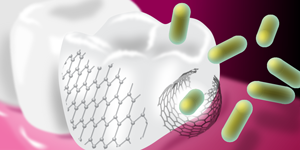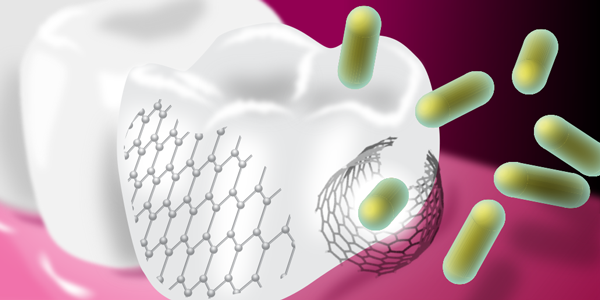(April Fools) A Killer App for Graphene
Graphene is thinner and stronger than any material. As a conductor of electricity, it outshines even copper. With attributes like these, graphene should be the king of materials. But as journalist John Colapinto pointed out in a recent New Yorker article, despite more than ten years of research and the enthusiastic efforts of thousands of scientists, the only two products on the market that use graphene are tennis rackets and conductive inks. The material, it seems, hasn’t yet delivered on all its promise.
This could soon change with the discovery, reported today, that adding small amounts of graphene to toothpaste reduces the damaging effects of bacteria. Bacteria feed off sugars in the mouth, releasing acid that erodes tooth enamel. According to the new research, graphene provides a protective layer that both protects enamel from these acids and kills the bacteria that cause cavities.
Adam Kiefer, of the National Institute of Advanced Materials and the lead author of the study, has spent his career studying the biological effects of materials, including graphene. Thumbing through a plaque-prevention brochure at his dentist’s office one day in 2013, he read about the chemistry of tooth decay. Kiefer realized that graphene’s unusual electronic structure might have the right properties to fight bacteria like Streptococcus mutans, which causes cavities.
First he studied the chemical interactions among graphene, enamel, and oral bacteria. Encouraged by what he saw, Kiefer enlisted his graduate students to try graphene toothpaste. After six weeks of testing, those students who had used the toothpaste had fewer plaque-forming bacteria than students in a control group. “I was shocked,” said Kiefer.
Graphene has two effects, explained Kiefer. First, it acts like fluoride, forming a protective layer on enamel that fights plaque—the sticky layer of bacteria that can lead to tooth decay. Kiefer performed neutron scattering experiments that revealed that graphene binds to the tooth’s surface without warping and losing its properties. The material’s highly mobile electrons prevent the sticking of adhesion proteins that normally connect plaque to enamel. Second, when mixed with toothpaste and saliva, some of the material forms particles of graphene oxide, a substance known for its antibacterial activity.
Markus Merk of the Max Planck Institute for Topological Physics in Dingenskirchen, Germany, who wasn’t involved in the research, said the finding is “Refreshing—and potentially very important.” But he thinks other materials could outperform graphene. “Graphene, unfortunately, has no spin-orbit coupling. But topological insulators do. Using these novel materials could increase the plaque-prevention efficiency of toothpastes by at least at liquid helium temperatures.”
Binaca Babool, the World Health Organization’s program director on teeth and gum health, thinks the research could “revolutionize” dental care. But she sees hurdles. “As children, we’re told not to eat pencils,” she said. “How will the average person feel about swallowing large amounts of graphene? And what about the sooty grey residue the graphene leaves on your teeth? That could make the product difficult to market.”
Kiefer remains optimistic. With a sizable grant from an undisclosed chemical company, he is planning larger-scale tests and branching out to other materials. In the last few weeks, he’s sprinkled manganites, high-temperature superconductors, and metamaterials on his wife’s toothbrush. “Materials discoveries have always involved an element of serendipity,” said Kiefer. “But I hope this is one that puts a smile on everyone’s face.”
This research is reported in Physical Review Graphene.
–The Editors





